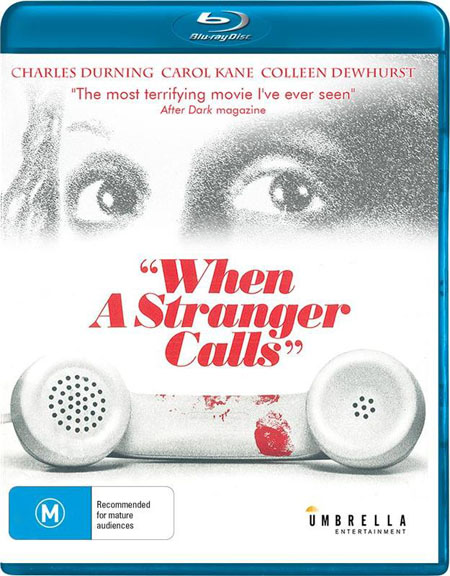
BY TODD GARBARINI
Just
after the school year ended in June 1984, I went to a friend’s house on a
Friday night to watch the premiere of Carlin
on Campus, an HBO concert of one of my favorite comedians, the legendary
George Carlin. When the concert was
over, my friend switched around until he reached NBC-TV. They were airing When A Stranger Calls, a 1979 thriller starring Carol Kane, Charles
Durning, and Colleen Dewhurst. I saw the
film from the beginning, and the first twenty or so minutes had me utterly captivated. It presented a scenario that I found to be
terrifying, and apparently so did Rex Reed, whose proclamation “some of the
most terrifying sequences ever filmed†was used in the newspaper ads. I thought it was so original – until I saw
Bob Clark’s frightening Black Christmas
(1974) four years later and saw where the “inspiration†may have come from. But my impressions of the film never left
me.
SPOILER
ALERT: If you don’t want the film’s plot spoiled, do not read this review any
further as certain aspects will be revealed.
Released
on Friday, October 12, 1979, Fred Walton’s When
A Stranger Calls pits babysitter Jill Johnson (Carol Kane) in the home of
Dr. Mandrakis (Carmen Argenziano) and his wife (Rutanya Alda) who are going out
for the evening. Their two children are
upstairs asleep. An hour later, Jill
gets a phone call wherein the caller hangs up, and then a second one where a
mysterious voice asks her, “Have you checked the children?†Initially she thinks this is a friend of hers
playing a prank, but after three more of these calls throughout the night she
calls the police who brush it off as innocuous. Several more calls of this nature compel her to call the police back,
and they agree to trace the call, which is a good thing as the caller is
calling from another phone line inside the house and, horrifically, has
murdered the two children she is in charge of baby-sitting.
The
film then flash forwards seven years to Dr. Mandrakis’s new digs in Beverly
Hills. He has summoned police detective John
Clifford (Charles Durning) who handled his case. Curt Duncan (Tony Beckley), the killer, has
escaped from a mental facility. Dr.
Mandrakis wants Clifford to find him and take appropriate action to make sure
he doesn’t harm anyone else. Clifford is
only too happy to oblige. How he hopes
to succeed with this plan is not addressed. Incredibly, he confides this to a peer.
The
film is a feature-length version of the same director’s 1977 short film The Sitter, upon which the opening
sequence of the feature film is based. Unfortunately, once this sequence is over, the film moves in a
completely different direction, one that is nearly bereft of suspense until the
final reel. It’s almost as if the
remaining 80 minutes are there as filler before the credits role. Colleen Dewhurst is quite good as a woman
living in an apartment who attracts the unwanted advances of Duncan, who
appears meek and pathetic, but what single/divorced woman walks home alone at
night through dark areas and empty stairwells, only to get home and leave her
apartment door opened? One of the
biggest missteps the film makes is following the killer around and almost
painting him as a sympathetic character. How he became a monster who could kill two innocent children is never
addressed. In Jonathan Demme’s The Silence of the Lambs (1991), the mere
presence of Hannibal Lecter left the audience frightened and on edge. That is not
the case with this guy, who was played by an actor who was terminally ill
during shooting and passed away in April 1980. His inability to emote anything that would instill fear plays against
the character.
Carl
Denham (Robert Armstrong) remarks in Willis O’Brien’s King Kong (1933) that “every legend has a basis of truth†and When A Stranger Calls is no
exception. A real-life case in March 1950 provided the basis for an urban legend
that persists even to this day and has become the inspiration for many
television shows and movies alike.
The
performances by those in the film are all quite good, especially Carol Kane as
the baby-sitter. The situation she finds
herself in at the end of the film has the elliptical storyline that has become
a common trope in the genre.
Dana
Kaproff, who
also scored Empire of the Ants
(1977), Death Valley (1982), and
innumerable made-for-TV movies including Wes Craven’s Chiller (1985) and Fred Walton’s I Saw What You Did (1988), the latter also revolving around a telephone,
provides an exceptional musical score that is deserving of a better movie. The score is available here
from Kritzerland on CD and is worth having even if you’re not a fan of the
film.
The
film inspired a 1993 sequel with Durning and Kane returning under the direction
of Walton. In 2006, a theatrical remake
was released.
The
Blu-ray from Umbrella is an Australian Region 4 disc that either needs to be played on an
all-region player or on a computer with a Blu-ray drive and software that
strips the regional encoding to permit playback. The image is good and has some grain, which
is expected for a film shot 36 years ago. If you’re a fan of the film and are able to play it back, this is a
decent release despite the lack of extras.